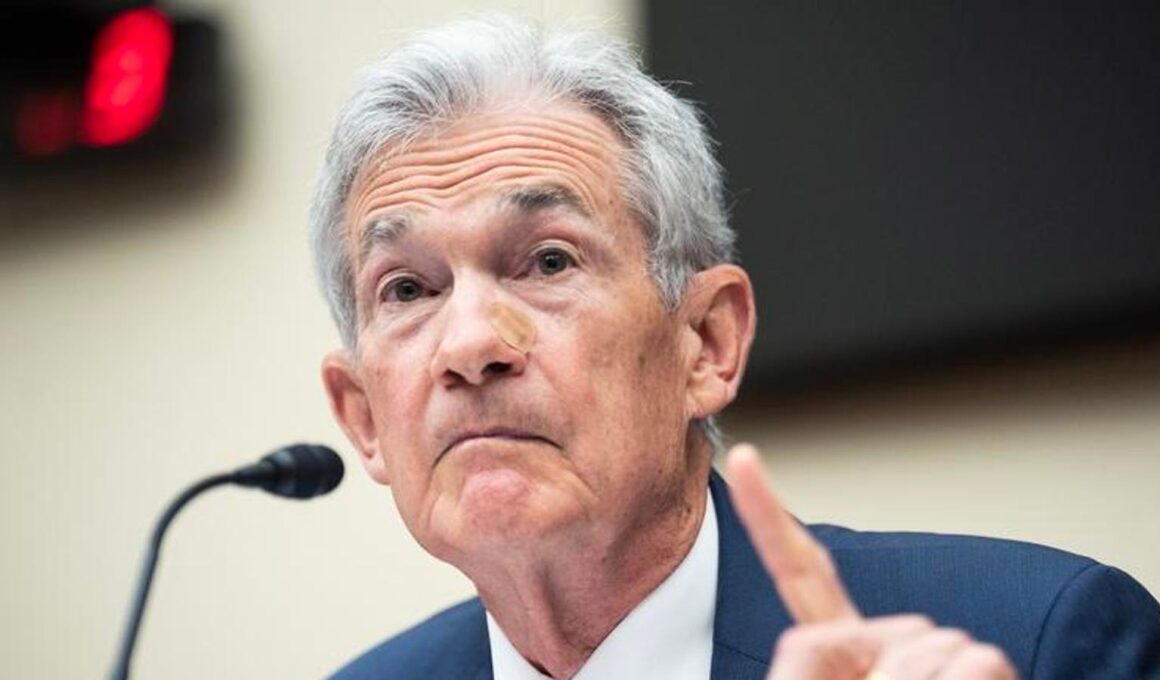Topline
The Federal Reserve announced Wednesday it will keep interest rates the same, as expected, but gave slight indications economic data should soon support a rate cut, a welcome sign for borrowers and investors rooting for rates to come down from their 23-year high.
Federal Reserve Chairman Jerome Powell testifies before Congress on July 10.
Key Facts
The Fed’s policy-determining Open Markets Committee (FOMC) announced it unanimously voted to keep the target federal funds rate at the 5.25% to 5.5% range they’ve sat since last July, following the committee’s two-day meeting.
The FOMC said in a press release there’s been “some further progress” in the battle against inflation and that it’s “attentive to the risks” of an economic slowdown, both of which should support cuts in the near future, as the Fed tends to lower rates when inflation subsides or when the labor market needs a jolt.
It’d be the first rate cut since March 2020, when the Fed slashed rates to near zero, before undertaking the severe tightening cycle as inflation raged to its steepest level since the early 1980s.
“A rate cut could be on the table at the September meeting,” the always coy Fed Chairman Jerome Powell said at a press conference, offering the clearest bread crumb yet that rates may soon come down should economic conditions continue in the same trajectory.
Stocks maintained their strong gains from earlier in the day as markets weighed “the subtle shift in tone” from the Fed, noted LPL Financial economist Jeffrey Roach in emailed comments.
Big Number
100%. That’s the market-implied odds of a rate cut at the Fed’s next conclave, which ends September 18, according to CME FedWatch Tool, which tracks futures contracts betting on the direction of the target federal funds rate.
Key Background
Investors may be certain that the Fed will soon lower rates for the first time since 2020, but the Fed often pulls the ball away from those who are overly confident in the direction of monetary policy. Consider that at the beginning of the year, the market priced in a 99% probability of three rate cuts by the July meeting, when of course there were zero such instances. The Fed sets the target federal funds rate, which nominally only impacts lending costs between banks but directly influences borrowing rates of all sorts. The federal funds rate, at 5.25% to 5.5% since last July, remains at its highest level since 2001, a far cry from the 0% to 0.25% range it stood from March 2020 to March 2022. Companies, investors and consumers tend to prefer lower rates, as they make loans to expand operations cheaper, make stocks more attractive as earnings power expands and stimulate spending as borrowers grow less fearful of high interest payments. The Fed hiked rates in 2022 in order to curb inflation, which hit its worst level since the early 1980s in 2022, as interest rate increases are the federal government’s primary tool to lower inflation as they broadly cool the economy, slowing price increases. Inflation has in turn cooled considerably, with the consumer price index’s annual inflation measure down to 3% last month, a fraction of June 2022’s 9.1% inflation but still above the long-accepted target of 2% inflation. But there are plenty of victories in the Fed’s war on inflation, including June to July marking the first month-over-month decline in consumer prices since 2020, which accelerated bets for upcoming rate cuts.
What We Don’t Know
What it will be that causes the Fed to finally lower rates. “The Fed’s singular focus on inflation has shifted in favor of a more balanced” approach, according to Bank of America economist Michael Gapen, adding “cuts can happen because the economy cools, because inflation slows, or both.” The U.S. economy hasn’t cracked yet, growing an above-trend 2.8% in the second quarter. Still, there’s plenty of evidence that Americans could benefit from a friendly rate cut, with savings rates plunging to a 2-year low and unemployment climbing to a two-year high in June.
Further Reading
Trump Media to the Saudi Arabian influence on golf and what real-life billionaires think of ” Succession.” Send tips to dsaul@forbes.com. Follow Saul for analysis on the biggest daily economic and stock market happenings, ranging from inflation data to tech earnings to deep-dives on hot button assets.
“>









